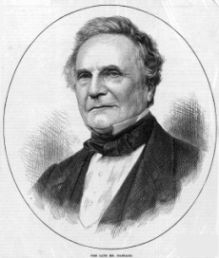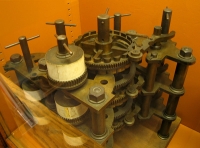|
| ||
|
| ||
Who was Charles Babbage?
Charles Babbage (1791 - 1871) was born in Devonshire, UK. Like John von Neumann , he was the son of a banker - Benjamin (Old Five Percent) Babbage. His family's wealth allowed Charles to live a comfortable life and to receive the very best education of his day. He attended Trinity College, Cambridge, where he founded the Analytical Society in 1812 and received his MA in 1817. Known to some as the "Father of Computing" Charles Babbage was a mathematician, philosopher and computer scientist who invented the first programmable computer called the analytical engine. Charles Babbage was also a prodigious inventor. The use of Jacquard punch cards (Joseph Jacquard was the inventor of the first programmable mechanical loom), of chains and sub-assemblies, and ultimately the logical structure of the modern computer were all pioneered by him. Some of his other inventions include: the locomotive pilot (aka the cowcatcher -- i.e. the metal frame attached to the front of locomotives that clears the tracks of obstacles.); the dynamometer; the standard railroad gauge; uniform postal rates; occulting lights for lighthouses; Greenwich time signals; the heliograph and the ophthalmoscope. In Babbage's time, numerical tables were calculated by humans called "computers." Consequently there was a really high error rate in the calculation of math tables. Charles Babbage's goal was to find a new method that could be used to make all calculations mechanically thereby removing all human error.  In 1822 Babbage presented designs for his first difference engine to the Royal Astronomical Society. Unlike similar efforts of the time, his difference engine was able to compute values of polynomial functions automatically by using the method of finite differences by which was possible to avoid the need for multiplication and division. It was composed of around 25,000 parts, weighed fifteen tons, and stood 2.4 m high. Although he received ample funding for his difference engine it was never completed. (Picture above shows part of Babbage's difference engine, assembled after his death.)
In 1822 Babbage presented designs for his first difference engine to the Royal Astronomical Society. Unlike similar efforts of the time, his difference engine was able to compute values of polynomial functions automatically by using the method of finite differences by which was possible to avoid the need for multiplication and division. It was composed of around 25,000 parts, weighed fifteen tons, and stood 2.4 m high. Although he received ample funding for his difference engine it was never completed. (Picture above shows part of Babbage's difference engine, assembled after his death.)Soon after the failed attempt at making the difference engine, Babbage started designing a more complex machine called the analytical engine that would be programmable to do any kind of calculation, not just ones relating to polynomial equations. An 1935 design for this machine reveals that the scale of the project was truly incredible. Babbage and a handful of assistants created 500 large design drawings, 1000 sheets of mechanical notation, and 7000 sheets of scribbles. Babbage constructed only small test parts for his analytical engine which was also never completed. The first design innovation was Babbage's decision to redirect the machine's output to the input for further equations. He described this as the machine "eating its own tail." Another pioneering innovation was the adoption of punch cards from the Jacquard loom used to specify the machine's input and operating instructions. The analytical engine consisted of two parts: the mill and the store. The mill was to measure 15 feet tall and 6 feet in diameter and was analogous to a modern computer's CPU which executes the operations on values retrieved from the the memory which in this case was a 100 digit mechanical store that would stretch up to 25 feet long. This machine also employed several other features subsequently used in modern computers such as sequential control, branching, and looping, and would have been the first mechanical device to be Turing-complete. Therefore Charles Babbage's analytical engine was the world's first general-purpose computer. Ada Lovelace, a brilliant mathematician, was one of the few people who fully understood Babbage's ideas. She created a program for the analytical engine and had the machine actually been built, her program would have been able to calculate a sequence of Bernoulli numbers. (Based on this work, Lovelace is now widely credited with being the first computer programmer and in 1979, a contemporary programming language was named Ada in her honor.) Between October 1846 and March 1849 Babbage started designing a second difference engine using knowledge gained from the analytical engine. It used only about 8000 parts, which was about three times fewer parts than the original design, and was a marvel of mechanical engineering.  Babbage made no attempt to actually construct his machine yet in 1991, a perfectly functioning difference engine was constructed from Babbage's original plans. Built to tolerances achievable in the 19th century, the success of the finished engine indicates that Babbage's machine would have worked. Nine years later, the Science Museum completed the printer Babbage had designed for the difference engine, an astonishingly complex device for the 19th century.
Babbage made no attempt to actually construct his machine yet in 1991, a perfectly functioning difference engine was constructed from Babbage's original plans. Built to tolerances achievable in the 19th century, the success of the finished engine indicates that Babbage's machine would have worked. Nine years later, the Science Museum completed the printer Babbage had designed for the difference engine, an astonishingly complex device for the 19th century. "If unwarned by my example, any man shall undertake and shall succeed in really constructing an engine ... upon difference principles or by simpler means, I have no fear of leaving my reputation in his charge, for he alone will be fully able to appreciate the nature of my efforts and the value of their results." To find out more about Charles Babbage, his life and his calculating machine inventions such as the analytical engine and the difference engine, please see the videos in the sidebar on the right. Do you want to sumbit your own singularity content?Do you agree or disagree with the content of this page? Do you want to improve it? Do you want to post some great singularity content of your own? Why not share it here at Singularity Symposium?! |
|
|
|
| ||
Internet gems
| ||
|
Copyright © 2012 - www.SingularitySymposium.com - All Rights Reserved
| ||




